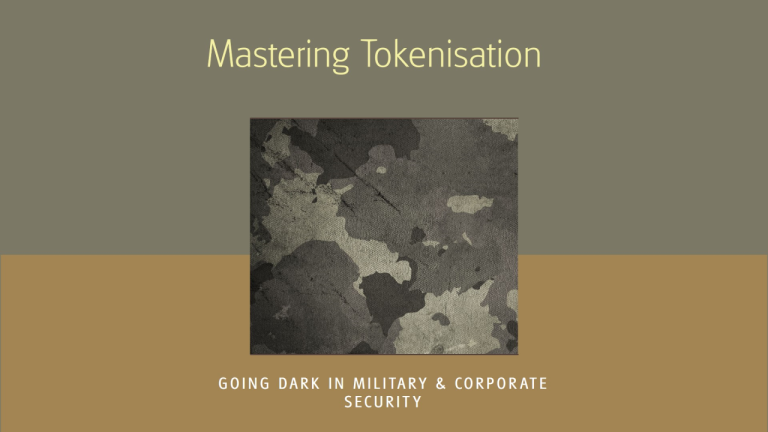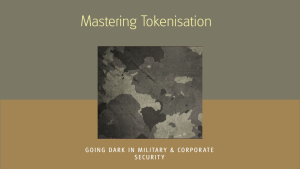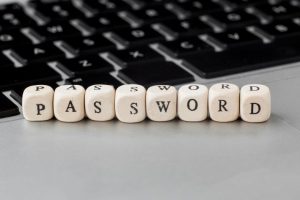CYBER AWARENESS: The Art of Tokenisation: Going Dark in Modern Military Ops & Corporate Security
July 25, 2024Helping keep European SMEs CYBERSafe!
Gibraltar: Thursday 25 July 2024 at 15:00 CEST
CYBER AWARENESS – Mastering the Art of Tokenisation: Going Dark in Modern Military Operations and Corporate Security
By Susan Brown | CEO Zortrex
via CYBERInsights
First for SME Cybersecurity News
#CyberInsights #SMECybersecurity #CyberSecurity #LockBit #SupplyChainAttack #FinancialSecurity #Zortrex #zortrexvault #tokenisationforthepeople #tokenisationresilience
Mastering the Art of Tokenisation: Going Dark in Modern Military Operations and Corporate Security
In the realm of modern military strategy, mastering the techniques of camouflage, concealment, deception, and dispersal is paramount. As the battlespace evolves, so too must our tactics and technologies. The concept of “going dark” – operating with reduced or degraded access to the electromagnetic spectrum – has become a crucial element of military doctrine. Tokenisation, a method traditionally associated with data security, now presents a compelling case for its broader application in enhancing operational security and effectiveness in this challenging environment. Companies can also leverage Tokenisation to bolster their security measures.
The Essence of Going Dark
Going dark refers to the deliberate reduction or cessation of electromagnetic emissions to avoid detection by adversaries. This strategy is critical in environments were maintaining stealth and avoiding electronic surveillance are essential for mission success. Traditional methods involve minimising radio communications, reducing radar signatures, and employing physical camouflage. However, as technological advancements continue to redefine the battlespace, new methods of achieving these goals are emerging.
Tokenisation: Beyond Data Security
Tokenisation involves replacing sensitive data with unique identifiers or tokens that are meaningless on their own. Unlike traditional obfuscation, which focuses on making data, code, or communications unintelligible to unauthorised users, tokenisation transforms the data into a form that is useless without the proper mapping back to the original information. When applied to military operations and corporate environments, Tokenisation can provide significant advantages in achieving concealment and deception, potentially replacing obfuscation in many scenarios.

Why Tokenisation Comes Out on Top
1. Superior Data Security
Dynamic Communication Protocols:
Tokenisation can be used to create dynamic and unpredictable communication protocols. By continually changing the tokens used in communications, military units and companies can obscure the nature and content of their transmissions, making it difficult for adversaries to intercept or decode them. This dynamic tokenisation ensures that even if transmissions are detected, they are rendered meaningless without the appropriate decryption keys.
Securing Command and Control:
In scenarios where command and control (C2) systems are at risk of being compromised, tokenisation can safeguard critical information. By tokenising orders and communications, the integrity and confidentiality of mission-critical data are maintained, even if the communication channels are compromised.
2. Enhanced Camouflage and Deception
Digital Camouflage:
Just as physical camouflage hides troops and equipment from visual detection, digital tokenisation can conceal digital footprints. Tokenising software and operational data can prevent adversaries from gaining insights into military capabilities and strategies through cyber reconnaissance.
Operational Deception:
Tokenisation techniques can be employed to create false signals and decoy communications. By generating and transmitting tokenised data that mimics real operational traffic, military units and companies can deceive adversaries about their true movements and intentions. This form of digital deception can be as effective as traditional physical decoys in misleading the enemy.
3. Scalability and Flexibility
Efficient Implementation:
Unlike obfuscation, which can involve complex and resource-intensive processes, tokenisation is straightforward to implement. It provides a scalable solution that can be easily integrated into existing systems without significant overhead.
Versatile Applications:
Tokenisation is highly versatile and can be adapted for various uses within military operations and corporate security, from securing communications to protecting sensitive data and enhancing operational deception. This flexibility makes it an ideal choice for a wide range of security needs.
4. Future-Proof Security
Adaptability to Emerging Threats:
As threats evolve, tokenisation can be adapted to meet new challenges. Its dynamic nature allows for continual updates and improvements, ensuring that it remains effective against emerging threats.
Integration with Advanced Technologies:
Tokenisation can be seamlessly integrated with other advanced security technologies, such as artificial intelligence and machine learning, to provide enhanced protection and operational capabilities.
Conclusion
The integration of Tokenisation into military operations represents a significant leap forward in the art of going dark. By leveraging Tokenisation, military forces and companies can enhance their ability to operate undetected, protect critical information, and deceive adversaries. This approach not only complements traditional methods of concealment and deception but also addresses the challenges posed by the increasingly digital and interconnected nature of modern warfare.
As the military and corporate environments continue to adapt to the complexities of the modern battlespace, mastering the art of Tokenisation will be essential. This technique offers a powerful means of achieving stealth and security, ensuring that operations can continue to thrive even in the most contested and hostile environments. In an era where electromagnetic dominance is often contested, the ability to go dark and operate effectively in the shadows will be a decisive factor in achieving mission success. Tokenisation, with its dynamic and versatile applications, stands at the forefront of this new wave of operational security measures.









